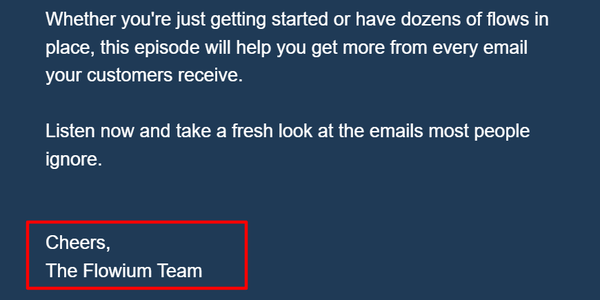A well-thought-out email outro is more important than you can imagine, much like a compelling introduction. The way you sign off emails can impact how people perceive your message and even your persona as a business partner, colleague, service provider, etc. With the right email endings, you can demonstrate professionalism, attention to detail, or a specific tone for your message.
To assist you in choosing the best email sign-off for different scenarios, we have created this guide. In this article, we’ll explain how to conclude an email correctly, offer you some tips from our marketing experts, and provide examples of email closings.
What Are Email Sign-Offs?
First, let’s outline the definition and the importance of these email closings.
An email sign-off is the last element you add to your email messages, right before the signature. It effectively summarizes your point, completes the impression about the tone of your message, and essentially doubles the sender’s name.

Choosing the right ways to sign off an email is the last step that guarantees your message gets delivered exactly as you meant; it’s similar to pressing the “send” button.
According to a survey conducted by Boomerang, a supplier of email productivity software, emails with a closing get more responses than the 47.5% average response rate for all emails.
As you can see, a correct email sign-off is more than just custom; it fulfills several important purposes:
- Signifies the End of the Message
It effectively concludes your communication by making it clear that your message has come to a close.
- Shows Politeness
Similar to saying “please” and “thank you” in real life, it’s a gesture of online etiquette.
- Establishes the Mood
It’s a no-brainer that you choose the tone of your message depending on the relationships with the people to whom you send your emails. Whether your communication is informal, professional, or friendly, the appropriate sign-off can support its tone.
- Adds Personal Touch
Depending on the phrases you use, it might lend a personal touch to a message, giving it a professional or warm feel.
Making an effort for a perfect email sign-off is a chance to make a lasting impression, in addition to being a sign of professionalism.
Overall, the art of selecting good email sign-offs involves striking a balance between context, intention, and etiquette.
How to Sign Off an Email?
Knowing what email sign-offs are is just the first part of the equation for writing your perfect ending. “How to end an email correctly?” is another question to which we fortunately have the answer ready.
There are many options and tips that we’re going to share, but first, we recommend taking your time to figure out your general points about your message. This will help you to write or choose the right approach to signing off an email.
Ask yourself the following questions:
- What is the email’s message?
Your choice of sign-off should be determined by the objective of your email. This goal should be reflected in your sign-off, whether you’re asking for something, giving information, or expressing thanks.
- What feeling do you wish to express?
If your message aims at expressing a certain emotion and invoking it in the recipient, make sure to back it up with your sign-offs for emails. No matter if it’s gratitude or regret, there are suitable words for every situation that we recommend using, so the ending of your message doesn’t feel out of place.
- Do you know the receiver well?
When choosing a suitable sign-off, the type of relationship you have with the recipient is crucial. While professional settings necessitate a more formal approach, a more casual and familiar relationship may provide a more relaxed sign-off.
- Is this an informal or formal email?
Make sure the tone of your email is reflected in your sign-off. A casual body and a formal sign-off that don’t match (or vice versa) can give the receiver conflicting messages.
- Do you expect a response or action?
If the goal of your email is to elicit a certain action or response, think about ending it with a gentle prod. Without being demanding, statements like “Looking forward to your feedback” or “Please let me know your thoughts at your earliest convenience” establish clear expectations.
You will be in a much better position to select the best sign-off for each email you send after you have addressed these questions.
Moreover, adding a polished, on-brand email signature to each email is the simplest way to make your emails appear professional, regardless of the email ending you decide on.
Best Email Sign-Off Examples
The appropriate closure can have a big impact on the recipient’s view, regardless of whether you want to keep the tone formal or add a personal touch.
To find out which lines are the best for your communication, let’s examine different email sign-off examples that fit every mood and occasion.
Professional Email Sign-Off Examples
This type of email sign-off is widely accepted and created for business settings. The main characteristics are that they maintain a respectful tone but also fit a straight-to-the-point communication style. It’s ideal for use in correspondence with clients, business partners, and networking.
Here are some examples of how to end an email professionally:
- Best regards,
- Sincerely,
- Kind regards,
- Thank you in advance,
- With appreciation,
- Respectfully,
- Continued success,
Corporate Email Sign-Offs
These email endings are tailored for a business environment and formal communication with colleagues, upper management links, stakeholders, etc. As you can predict, the tone for such correspondence should be highly professional and polite.
These are the options you can use in the said settings without being worried about stepping out of line:
- In corporate unity,
- Warmest regards,
- Looking forward to your response,
- Committed to your success,
- With professional regards,
- Thank you for your attention,
- Eagerly awaiting your thoughts,
- Cordially,
Unique Email Sign-Offs
If you want your message ending to be more memorable and the relationships with the receiver allow it, you can use creative email sign-offs. Here, we prepared some examples with more unique phrases that simultaneously fit the professional environment and express your creativity.
- In continued collaboration,
- Onward and upward,
- Cheers to a fruitful collaboration,
- Until our next exchange,
- Keep soaring,
- With clarity and purpose,
- Digitally yours,
- Until we meet in the inbox again,
Fun Email Sign-Offs
It’s not necessary to take email sign-offs seriously. Including a hilarious email sign-off can make people laugh, but only with close coworkers and familiar clients.
- Stay awesome!
- Catch you on the flip side,
- May your inbox be ever light,
- Cheers and confetti,
- Keep being great,
- All the best, except for Mondays!
Friendly Email Sign-Offs
These are friendly and approachable without being overly informal, which helps to preserve a good relationship. Excellent for coworkers, frequent clients, or collaboration partners.
- Warm wishes,
- Always here to help,
- Great working with you,
- Thanks again!
- Until next time,
- Take it easy,
Warm Email Sign-Offs
These email sign-off examples maintain professionalism while expressing kindness, empathy, and concern. Ideal for delicate topics, client interactions, or wellness-focused companies.
- With warmth,
- Sending good vibes,
- Wishing you a great day,
- Warm regards,
- With heartfelt thanks,
- Warm wishes,
- All my best,
Casual Email Sign-Off Examples
A higher level of familiarity with the email receiver calls for a more casual style of communication. You’d probably agree that it would be strange to receive a formal message from someone you’re close with. Therefore, we recommend opting for casual email sign-offs that will fit this type of relationship, but won’t seem overly forward or bold.
- Cheers,
- All the best,
- Talk soon,
- Have a good one,
- Take care,
- Later!
- Catch up soon,
- See you around,
Formal Email Sign-Off Examples
Contrary to the previous type, some emails require your tone to be strictly reserved, respectful, and traditional. It resembles the style of corporate and professional sign-offs but can be used in a wider range of settings, e.g., legal, academic, high-stakes professional, etc.
- Yours sincerely,
- With utmost respect,
- With highest regards,
- Respectfully yours,
- Yours in service,
- With due consideration,
Polite Email Sign-Offs
A “Thank you” email sign-off isn’t the only option if you want to express gratitude and courtesy to your correspondent. It’s also ideal for customer support, service industries, and when making some kind of request. Use the following expressions to show your appreciation and make a good impression.
- Thank you for your time,
- With thanks,
- In appreciation of your efforts,
- Much appreciated,
- Gratefully,
- Many thanks,
Best Email Sign-Offs for Ecommerce
Ecommerce business email sign-offs used in promotions usually differ from corporate and personal correspondence. They might include an additional call to action or a response to a certain client action resulting in a conversion. The examples you see below work well with thank-you emails, order confirmations, promotional campaigns, abandoned cart reminders, and more.
- Thanks for shopping with us,
- Happy shopping,
- Stay connected,
- Your [Brand Name] Team,
- See you again soon,
- Thank you for choosing [Brand Name],
- With gratitude,
How to End an Email: Our Recommendations
Your industry, the circumstance, your relationship with the recipient, and cultural considerations are some of the variables that affect the ideal email sign-off. The secret is to pay attention to these factors and select a conclusion that supports your professional image and is consistent with your message.
- Be Wary of Creativity
Not everyone will understand creative email sign-offs. Make sure your sign-off is acceptable and unambiguous.
- Remain On-Brand
Make use of a sign-off that accurately represents your business. For uniformity, use centrally managed email signatures.
- Play It Safe
To avoid coming out as unprofessional, use a neutral farewell such as “Regards” if you’re not sure.
- Mirror the Sender’s Sign Off
If appropriate, match the sign-off of the original sender when responding.
- Use Correct Grammar and Punctuation
Make sure your sign-off is punctuated correctly throughout, starting with a capital letter and ending with a comma. Your professionalism and attention to detail are demonstrated by this.
- Optimize and Change
To keep your emails from getting boring, feel free to change your sign-off depending on the receiver and the meaning of the email. This method keeps your emails lively and interesting.
- Personalize When Appropriate
After you and the recipient are on good terms, add some individuality. Remain both pleasant and professional.
- Be Respectful
Always end an email with a polite salutation. Across decades and cultures, “best wishes” is a universal expression.
What to Avoid in Your Email Sign-Offs
To preserve professionalism and clarity in your interactions, you should refrain from the following habits, even if there are numerous efficient methods to end an email:
- No Unnecessarily Formal or Archaic Phrases
Phrases like “Yours faithfully” can come across as inappropriate in emails and give off an air of being out of date.
- Avoid Being Overly Emotional
Use loving goodbyes like “Love” or “XOXO” only in private communications. They may be viewed as unsuitable or too familiar in professional settings.
- Avoid Using Slang or Acronyms
Professional emails should steer clear of slang, acronyms, and informal language that could confuse the receiver or give the impression that the sender is not professional.
- No Negative or Passive-Aggressive Language
There should never be a sour taste after a sign-off. Make sure your conclusion is sincere and free of any subliminal hostility or negativity.
Final Thoughts
Keep in mind that your email sign-off is a crucial component of your entire email marketing strategy. It’s a tiny but effective tool that can help you establish rapport, communicate the personality of your company, and make an impact on your recipients that will remain. We hope this article has helped you understand the importance of adding this element to your messages and shown the best ways to sign off an email. If you still don’t know which approach would be best, reach out to us for further consultation.
FAQ
- What kinds of email sign-offs are there?
Email sign-offs can be broadly classified according to the content and tone of your message. They each have a distinct function and target audience, ranging from formal and businesslike to informal and friendly.
- What should you include in your email sign-off?
Every sign-off should include a polite concluding line that reflects the tone of your email, followed by your name. Depending on the email’s formality and context, you may also choose to include your contact details, job title, and company name.
- Do cultural differences imply different ways to sign off an email?
Knowing that different cultures may have different communication conventions that affect how you end emails can help you prevent miscommunications and demonstrate consideration for cultural sensitivity. Email closings might be more formal in some cultures than others. Some cultures, on the other hand, favor more informal closings. For example, “Best regards” and “Sincerely” are frequently used in professional contexts in many English-speaking nations. Professional emails in Australia are frequently concluded with more casual phrases like “Cheers.”
- Should you consider age difference when signing off an email?
Yes, generational differences can have an impact on email sign-offs, just as cultural backgrounds do. When it comes to ending emails, different age groups typically have distinct preferences. For example, writing something casual to a Baby Boomer who prefers formal speech can make you seem unserious and unprofessional. Even though it’s a generalization and people from older generations can use a casual style too, we recommend being mindful of this difference, especially if you’re not familiar.





